| 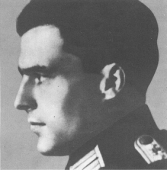 |
|  |

 Ursula's
History Web
Ursula's
History Web…he shouted in German and then they shot him. It was shortly after midnight on July 21, 1944, at the end of a terrible day where all had gone so wrong. The bomb he had placed at Hitler’s HQ at Wolf’s Lair had detonated, killing 4 and wounding several. But Hitler once again would tell the German people that a guardian angel had protected him. His name was Claus, Count von Stauffenberg. He was one of those professional German officers whom Hitler never had understood. In every way he was the opposite of Hitler. 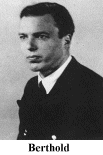 He
was an aristocrat from a long line of noblemen, a devout Catholic,
brilliant scholar, and accomplished horseman, a lover of music and
poetry. Through his mother he was descended from General Count von
Gneisenau, the famous field marshal of the Prussian army. Stauffenberg
belonged to the organizational department of the Army High Command. He
was up high enough to have direct access to Hitler. Often he had stood
three feet from the man he regarded as "the enemy of humanity." He
was an aristocrat from a long line of noblemen, a devout Catholic,
brilliant scholar, and accomplished horseman, a lover of music and
poetry. Through his mother he was descended from General Count von
Gneisenau, the famous field marshal of the Prussian army. Stauffenberg
belonged to the organizational department of the Army High Command. He
was up high enough to have direct access to Hitler. Often he had stood
three feet from the man he regarded as "the enemy of humanity."  For some time had he been
plagued by treasonable thoughts, and had joined a group of
conspirators, including his brother Berthold von Stauffenberg and his
cousin, Caesar von Hofacker. For some time had he been
plagued by treasonable thoughts, and had joined a group of
conspirators, including his brother Berthold von Stauffenberg and his
cousin, Caesar von Hofacker.On April 7, 1943 Stauffenberg’s staff car was riddled with bullets from a low-flying airplane near the Kasserine Pass in Tunesia. He lost an eye, his right hand and two fingers of his left hand. He then was flown to a military hospital in Munich. During his recovery he told friends who came to visit that he made the decision to sacrifice himself in order to kill Hitler. 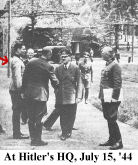 This
of course was not easy. Hitler was well protected by bodyguards, all of
them excellent marksmen. His traveling timetable was nearly always
changed at the last minute and in fact, he was rarely where people
expected him to be. The conspirators decided against shooting him; if
the first shot missed it was highly unlikely they would get a second
chance. So, they turned to time bombs. Several attempts failed, mostly
because Hitler changed his schedule and on one occasion a bomb placed
in Hitler’s plane failed to detonate. On July 20, 1944 Count
von Stauffenberg made his last attempt. This
of course was not easy. Hitler was well protected by bodyguards, all of
them excellent marksmen. His traveling timetable was nearly always
changed at the last minute and in fact, he was rarely where people
expected him to be. The conspirators decided against shooting him; if
the first shot missed it was highly unlikely they would get a second
chance. So, they turned to time bombs. Several attempts failed, mostly
because Hitler changed his schedule and on one occasion a bomb placed
in Hitler’s plane failed to detonate. On July 20, 1944 Count
von Stauffenberg made his last attempt.
July 20, 1944 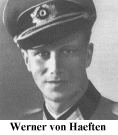 Arriving at the Rangsdorf
airfield shortly before seven am, his friend, General Helmut Stieff
handed him 2 bombs; Stauffenberg wrapped a shirt around one of the them
and placed it in his briefcase and his adjutant, Lt. Werner von
Haeften, did the same with the other one. They reached the airfield
near Hitler’s headquarter at 10:15 am. Lt. Col. Streve, the
commandant of the HQ gave instructions to let them pass. They had
breakfast with Streve and at 11:30 am Stauffenberg met with General
Buehle. At noon he took Stauffenberg to General Keitels’
office, where he learned that the conference with Hitler would take
place at 12:30 pm instead of 1pm as Mussolini was arriving that
afternoon at 3 o’clock. Everything went as planned. The only
disturbing news was that the conference would not take place in the
underground bunker as had been scheduled, but in a hut on the grounds,
called the Lagebarracke. It was a small single-story wooden building
with just enough space for a conference
room, a battery of telephones, a cloak- room, a wash room and
an entrance hall. Arriving at the Rangsdorf
airfield shortly before seven am, his friend, General Helmut Stieff
handed him 2 bombs; Stauffenberg wrapped a shirt around one of the them
and placed it in his briefcase and his adjutant, Lt. Werner von
Haeften, did the same with the other one. They reached the airfield
near Hitler’s headquarter at 10:15 am. Lt. Col. Streve, the
commandant of the HQ gave instructions to let them pass. They had
breakfast with Streve and at 11:30 am Stauffenberg met with General
Buehle. At noon he took Stauffenberg to General Keitels’
office, where he learned that the conference with Hitler would take
place at 12:30 pm instead of 1pm as Mussolini was arriving that
afternoon at 3 o’clock. Everything went as planned. The only
disturbing news was that the conference would not take place in the
underground bunker as had been scheduled, but in a hut on the grounds,
called the Lagebarracke. It was a small single-story wooden building
with just enough space for a conference
room, a battery of telephones, a cloak- room, a wash room and
an entrance hall.The conference that had already begun when Stauffenberg arrived with Keitel. It was 12:32 PM and the bomb he carried had a time span of 10 minutes. It took 3 minutes to reach the conference room, and in the remaining 7 minutes he had to place the bomb close to Hitler and find an excuse to leave the room without attracting attention. Stauffenberg took his place near the right-hand corner of the table, bent down and placed his briefcase on the floor. The table rested on two heavy oak slabs. The briefcase was standing against on of those slabs. Stauffenberg suddenly got up, said he had to make an important telephone call, and left the building. Col. Brandt took his seat, bent down and moved the briefcase because it was in his way. Hitler was leaning across the table when General Heusinger concluded his report: "…and if the army group around Lake Peipus is not withdrawn immediately, there will be a catastrophe". At this precise moment the entire conference room was engulfed in a blinding flash of flame and a sound was heard like a roaring train. The heavy table rose into the air and landed in a corner, with splinters flying in all directions, lacerating and burning almost everyone. At first the people in the building thought that they had been hit by a bomb from a low-flying Russian plane that somehow had come through the radar and anti aircraft screen, but this idea was quickly dismissed as no one had heard a plane. 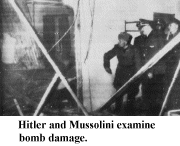 Keitel was
the first to suspect Col. von Stauffenberg, who by now was in the small
Heinkel on his way back to Berlin. He had stood about 100 yards from
the building at the time of the explosion and had assumed all were
killed. Keitel was
the first to suspect Col. von Stauffenberg, who by now was in the small
Heinkel on his way back to Berlin. He had stood about 100 yards from
the building at the time of the explosion and had assumed all were
killed.When the plane touched down at Rangsdorf near Berlin, they were surprised that no car was waiting for them. Stauffenberg’s adjutant called the OKW, army headquarters at Bendler Strasse, and told them that Hitler was dead. By the time they reached Stauffenberg’s office at Bendler Strasse, the wheels of conspiracy were finally slowly starting to turn. Calls were made to Paris, where General Stulpnagel promptly arrested all SS leaders. 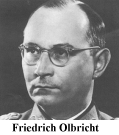 Then General Fromm,
Commander-in-chief of the reserve army called Hitler’s
headquarter and spoke to Keitel. He was informed that Hitler was only
slightly wounded and that Stauffenberg was suspected of being
responsible for the explosion. Stauffenberg still thought it was a
bluff and that indeed Hitler was dead. Although he was one of the
conspirators, Fromm, trying to save himself, ordered the arrest of
General Olbricht and Colonel von Stauffenberg. They resisted, arrested
General Fromm instead and placed him in his own adjutant’s
office without a guard. Then General Fromm,
Commander-in-chief of the reserve army called Hitler’s
headquarter and spoke to Keitel. He was informed that Hitler was only
slightly wounded and that Stauffenberg was suspected of being
responsible for the explosion. Stauffenberg still thought it was a
bluff and that indeed Hitler was dead. Although he was one of the
conspirators, Fromm, trying to save himself, ordered the arrest of
General Olbricht and Colonel von Stauffenberg. They resisted, arrested
General Fromm instead and placed him in his own adjutant’s
office without a guard.Hitler called Goebbels in Berlin and informed him that some kind of military putsch was taking place. 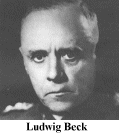 When
Goebbels realized that the conspirators had failed to take the obvious
precautions, such as securing the radio station, etc., he organized, at
once, some counter-measures. While the group at army headquarters were
busy making hundreds of telephone calls to Paris, Munich and Vienna,
several SS men entered their offices around 10 PM and started shooting.
After Stauffenberg was hit in the left arm, General Fromm emerged from
his hiding place and held an impromptu court-martial. The two generals,
Beck and Hoepner, were given a choice of suicide or arrest. When
Goebbels realized that the conspirators had failed to take the obvious
precautions, such as securing the radio station, etc., he organized, at
once, some counter-measures. While the group at army headquarters were
busy making hundreds of telephone calls to Paris, Munich and Vienna,
several SS men entered their offices around 10 PM and started shooting.
After Stauffenberg was hit in the left arm, General Fromm emerged from
his hiding place and held an impromptu court-martial. The two generals,
Beck and Hoepner, were given a choice of suicide or arrest. 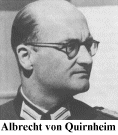 General Beck tried to shoot
himself in his office, but failed, and the SS shot him on the spot.
General Hoepner was arrested and Stauffenberg, Quirnheim, Olbricht and
Haeften were taken into the inner courtyard behind the office building.
Sandbags were placed against the building, and one by one the four
officers were marched in front of them. Headlights from Army trucks
were illuminating the courtyard and just before they fired,
Stauffenberg shouted: "Lange lebe unser heiliges Deutschland." General Beck tried to shoot
himself in his office, but failed, and the SS shot him on the spot.
General Hoepner was arrested and Stauffenberg, Quirnheim, Olbricht and
Haeften were taken into the inner courtyard behind the office building.
Sandbags were placed against the building, and one by one the four
officers were marched in front of them. Headlights from Army trucks
were illuminating the courtyard and just before they fired,
Stauffenberg shouted: "Lange lebe unser heiliges Deutschland."The aftermath of the conspiracy 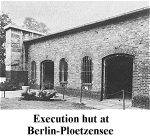 In the days and weeks following
the failed attempt, the SS arrested 7000 people, of which about 2000
were sentenced to death. Roland Freisler was placed in charge of the
Volksgerichthof, the "People’s Court." No defense was
permitted and Freisler took pleasure in mocking the doomed. One can
hear his voice on a recording in Stauffenberg’s office, which
is now a memorial (Bendler Strasse has been re-named Stauffenberg
Strasse). Freisler was killed during an airraid on Berlin as he rushed
from the courtroom in which his head was crushed by a falling beam. In
his hands was the file against Fabian von Schlabrendorff, one of the
few conspirators to survive. In the days and weeks following
the failed attempt, the SS arrested 7000 people, of which about 2000
were sentenced to death. Roland Freisler was placed in charge of the
Volksgerichthof, the "People’s Court." No defense was
permitted and Freisler took pleasure in mocking the doomed. One can
hear his voice on a recording in Stauffenberg’s office, which
is now a memorial (Bendler Strasse has been re-named Stauffenberg
Strasse). Freisler was killed during an airraid on Berlin as he rushed
from the courtroom in which his head was crushed by a falling beam. In
his hands was the file against Fabian von Schlabrendorff, one of the
few conspirators to survive.  Berthold,
Count von Stauffenberg (the brother of Claus), Count von Schulenburg
and Commander Alfred Kranzfelder were tried together at the
People’s Court on August 10, 1944, sentenced to death and
hanged that same afternoon in the most cruel manner at the execution
hut in Berlin-Ploetzensee. Stauffenberg’s cousin Caesar von
Hofacker was condemmed to death on Aug. 30th. He was kept alive for
over three months, unsuccessfully interrogated about Rommel’s
and Speidel’s involvement in the conspiracy and was hanged on
Dec. 20, 1944. Berthold,
Count von Stauffenberg (the brother of Claus), Count von Schulenburg
and Commander Alfred Kranzfelder were tried together at the
People’s Court on August 10, 1944, sentenced to death and
hanged that same afternoon in the most cruel manner at the execution
hut in Berlin-Ploetzensee. Stauffenberg’s cousin Caesar von
Hofacker was condemmed to death on Aug. 30th. He was kept alive for
over three months, unsuccessfully interrogated about Rommel’s
and Speidel’s involvement in the conspiracy and was hanged on
Dec. 20, 1944.The third brother, Alexander, Count von Stauffenberg was brought back from Athens to Berlin. When it became clear that he was not involved in the conspiracy, he was place in "Kith and Kin" custody and held in various concentration camps. His wife Melitta had also been arrested, but was released on Sept.2 to resume her vital research in aeronautics and as a test pilot. Countess Nina von Stauffenberg, the widow of Claus, was held at the prison at Berlin's Alexanderplatz, where she gave birth to Stauffenberg’s daughter Konstanze in January 1945. She and the child were taken to St. Joseph’s hospital in Potsdam. Almost all of Stauffenberg’s relatives were imprisoned including his uncle Nikolaus, age 85, who died in prison in November '44. His cousin Clemens became ill at Oranienburg-Sachsenhausen camp, and through Melitta’s intervention he was transferred to the hospital in Potsdam and after his recovery, Melitta flew him to Hof. His wife Elizabeth, who had been permitted to join him at the hospital, had to return to Buchenwald concentration camp, where she was imprisoned along with Alexander, Berthold’s widow Mika, Elisabeth Stauffenberg and others. During their imprisonment, they saw Melitta fly over the camp twice. Melitta also had discovered where the children of the dead brothers and their cousin Caesar von Hofacker were held. The SS had taken the children to Bad Sachsa in the region of the Harz mountains. On April 8, 1945, Melitta was on her way to visit her husband Alexander in a camp near Passau, flying a slow unarmed Buecke 181 trainer, and was shot down from behind by an American fighter. She managed to land her plane, but died two hours later from the bullet wounds she had received. Stauffenberg’s mother, Caroline, Countess von Stauffenberg, was in solitary confinement from July 23, 1944 until the end of the war. Not until December '44, did she hear of the death of her son Berthold and her brother Nikolaus. All properties of the conspirators and their relatives was confiscated. After the war, they had to struggle with German bureaucracy for restitution and pensions for widows and orphans. The plot failed, but was it meaningless? Certainly in 1944, with the Allies racing towards certain victory, there was little hope of securing a peace treaty which would not leave Germany crippled. The conspirators had appealed without success to the Western powers for guarantees of a democratic Germany. Their approaches were understandably misinterpreted. The hardest peace would have been easier to bear than the terrible sacrifices which Germany and all of Europe would have to make until May 1945. In the nine months following July 20th more people were killed and more buildings, economic installations and cultural treasures were destroyed than in all the war years that had gone before. Sixteen and a half million Germans had to leave their homes and two and half million of them died in the course of expulsion or flight. Perhaps even the division of Germany would not have come about if the plot had been successful, thus it was not meaningless.Standing alone, misunderstood by the world outside and without any assurance of success, the German resistance demonstrated that not all Germans had been infected by the disease of totalitarianism, that in Germany the tradition of inviolable human rights could not be destroyed. 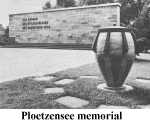 In giving
their lives, the men and women of the resistance made it possible to
build a democracy in the tradition of a new, better Germany and to
regain the respect of the peoples of the world. On the tenth
anniversary of July 20th the late Federal President Theodor Heuss
expressed it thus: "Gratitude recognizes, however, that the failure of
their undertaking does not rob the symbolic character of their
sacrifice of any of its dignity: here, at a time when infamy and the
cowardly, and therefore brutal concept of power had defiled and
besmirched the name of Germany, was the determination---fully aware of
the danger to life---to rescue the state from this murderous, evil
regime and, if possible, to save the Fatherland from utter destruction.
The legacy remains a living force; but our obligations have not yet
been discharged." In giving
their lives, the men and women of the resistance made it possible to
build a democracy in the tradition of a new, better Germany and to
regain the respect of the peoples of the world. On the tenth
anniversary of July 20th the late Federal President Theodor Heuss
expressed it thus: "Gratitude recognizes, however, that the failure of
their undertaking does not rob the symbolic character of their
sacrifice of any of its dignity: here, at a time when infamy and the
cowardly, and therefore brutal concept of power had defiled and
besmirched the name of Germany, was the determination---fully aware of
the danger to life---to rescue the state from this murderous, evil
regime and, if possible, to save the Fatherland from utter destruction.
The legacy remains a living force; but our obligations have not yet
been discharged."Claus, Graf von Stauffenberg sacrificed himself for his children, his people, for the honor of the army as he knew it, and for his country he loved above all. References Stauffenberg: A Family History, 1905-1944. Hoffman, Peter. Cambridge University Press, 1995. |
 for more.
for more.